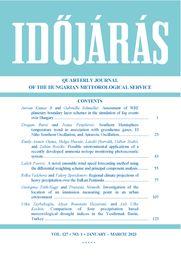Időjárás - Quarterly Journal of the Hungarian Meteorological Service (OMSZ)
Vol. 127, No. 1 * Pages 1–142 * January - March 2023
 |
|
 download [pdf: 5762 KB]
download [pdf: 5762 KB]
Assessment of WRF planetary boundary layer schemes in the simulation of fog events over Hungary
Jeevan Kumar B and Gabriella Schmeller
DOI:10.28974/idojaras.2023.1.1 (pp. 1–22)
Jeevan Kumar B and Gabriella Schmeller
DOI:10.28974/idojaras.2023.1.1 (pp. 1–22)
Southern Hemisphere temperature trend in association with greenhouse gases, El Niño Southern Oscillation, and Antarctic Oscillation
Dragan Burić and Ivana Penjišević
DOI:10.28974/idojaras.2023.1.2 (pp. 23–42)
Dragan Burić and Ivana Penjišević
DOI:10.28974/idojaras.2023.1.2 (pp. 23–42)
Possible environmental applications of a recently developed ammonia isotope monitoring photoacoustic system
Emily Awuor Ouma, Helga Huszár, László Horváth, Gábor Szabó, and Zoltán Bozóki
DOI:10.28974/idojaras.2023.1.3 (pp. 43–53)
Emily Awuor Ouma, Helga Huszár, László Horváth, Gábor Szabó, and Zoltán Bozóki
DOI:10.28974/idojaras.2023.1.3 (pp. 43–53)
A novel ensemble wind speed forecasting method using the differential weighting scheme and principal component analysis
Laleh Parviz
DOI:10.28974/idojaras.2023.1.4 (pp. 55–76)
Laleh Parviz
DOI:10.28974/idojaras.2023.1.4 (pp. 55–76)
Regional climate projections of heavy precipitation over the Balkan Peninsula
Rilka Valcheva and Valery Spiridonov
DOI:10.28974/idojaras.2023.1.5 (pp. 77–106)
Rilka Valcheva and Valery Spiridonov
DOI:10.28974/idojaras.2023.1.5 (pp. 77–106)
Investigation of the location of an immission measuring point in an urban environment
Georgina Tóth-Nagy and Fruzsina Németh
DOI:10.28974/idojaras.2023.1.6 (pp. 107–122)
Georgina Tóth-Nagy and Fruzsina Németh
DOI:10.28974/idojaras.2023.1.6 (pp. 107–122)
Comparison of four precipitation based meteorological drought indices in the Yesilirmak Basin, Turkey
Utku Zeybekoglu, Alyar Boustani Hezarani, and Aslı Ulke Keskin
DOI:10.28974/idojaras.2023.1.7 (pp. 123–142)
Utku Zeybekoglu, Alyar Boustani Hezarani, and Aslı Ulke Keskin
DOI:10.28974/idojaras.2023.1.7 (pp. 123–142)
IDŐJÁRÁS - Quarterly Journal

Az IDŐJÁRÁS a HungaroMet Nonprofit Zrt. negyedévenként megjelenő angol nyelvű folyóirata
Megrendelhető a journal.idojaras@met.hu címen.
A szerzőknek szánt útmutató itt olvasható.
Megrendelhető a journal.idojaras@met.hu címen.
A szerzőknek szánt útmutató itt olvasható.









